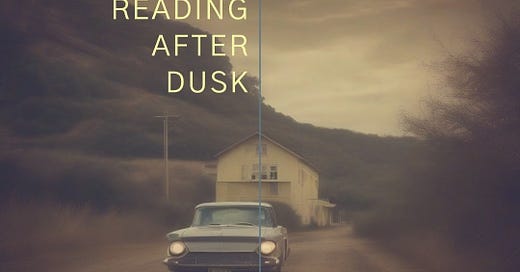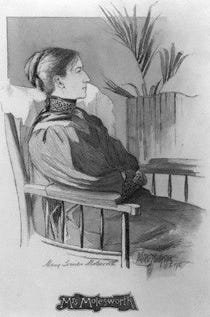Ten supernatural stories by Mary Louisa Molesworth (1839-1921)
"After all, one likes to think one's ancestors were gentlemen!"
Readers unfamiliar with Mary Louisa Molesworth may wish to read these notes only after reading the two collections.
Four Ghost Stories (1888) by Mary Louisa Molesworth
"Lady Farquahar's Old Lady" observes and marks the end of an Irish family: the Fitzgeralds.
Our narrator sums up "real" ghost stories thus:
"....Genuine ghost stories are generally abrupt and inconsequent in the extreme, but on this very account all the more impressive. Don't you think so?"
Lady Farquhar acknowledges this, then relates her own experience of just such a banal interlude. When a young woman, her family leased Ballyreina, owned by the three surviving Fitzgerald sisters. Destitute, the sisters had moved to Europe, where they traveled on foot.
The old lady ghost seen by Lady Farquhar apparently returned to visit a certain room at Ballyreina in the month of her death:
....The room with the old-fashioned furniture had been reserved by the owners of the place to leave some of their poor old treasures in—relics too cumbersome to be carried about with them in their strange wanderings, but too precious, evidently, to be parted with. We, of course, never could know what may not have been hidden away in some of the queer old bureaux I told you of. Family papers of importance, perhaps; possibly some ancient love-letters, forgotten in the confusion of their leave-taking; a lock of hair, or a withered flower, perhaps, that she, my poor old lady, would fain have clasped in her hand when dying, or have had buried with her. Ah, yes; there must be many a pitiful old story that is never told."
"Witnessed by Two" has a deflating effect after the poignant resolution of “Lady Farquahar's Old Lady,” which is at least a tale of deft poignancy. “Witnessed by Two” samples it's melodramatic wares too frequently — especially coincidence.
"Unexplained” follows experiences of an English mother and her two children during an overnight stay in what initially seems to be a cutthroat inn in a forgotten corner of Germany.
Molesworth allows plenty of time for itinerary and the collapse of arrangements before the fateful night. She then dashes ahead two years to sew-up coincidences in time for the chilling explanation.
"The Story of the Rippling Train" is not about locomotion. The train in question is a piece of fabric that unites a man and a woman who never found the connection both wanted more than either could acknowledge.
"I never knew the exact date of the accident," said Mr. Marischal, "but that of her death was fully six months after I had seen her. And in my own mind, I have never made any doubt that it was at or about, probably a short time after, the accident, that she came to me. It seemed a kind of appeal for sympathy—and—a farewell also, poor child."
They all sat silent for some little time, and then Mr. Marischal got up and went off to his own quarters, saying something vaguely about seeing if his letters had gone.
Mr. Marischal has narrated his anecdote to a small circle of intimate family, and their discussion of his fortunes after he has left the room adds to Molesworth’s atmosphere of condensing seriousness.
Uncanny Tales (1896) by Mary Louisa Molesworth
"The Shadow in the Moonlight" is a first-rate antiquarian ghost story. It follows a family, recovering from influenza, who select a 400-year-old pile as their place of rest and recreation. During their convalescence, and after their return home, they find themselves the recipient of repeated visits by a chilling entity.
"Next morning, on pretence of examining the date of the tapestry, we had it down—you were all out—and we found—something. Just where the hands felt about, there had been a cut—three cuts, three sides of a square, as it were, making a sort of door in the stuff, the fourth side having evidently acted as a hinge, for there was a mark where it had been folded back. And just where—treating the thing as a door—you might expect to find a handle to open it by, we found a distinct dint in the tapestry, as if a button or knob had once been there. We looked at each other. The same idea had struck us. The tapestry had been used to conceal a small door in the wall—the door of a secret cupboard probably. The ghostly fingers had been vainly seeking for the spring which in the days of their flesh and bone they had been accustomed to press.
‘"The Man with the Cough"' is a brief crime thriller. A young German engineer is dispatched by his firm to the UK with valuable patent documents. Part of his nighttime rail journey takes on a hallucinatory character. Are the men he meets the next day bona fide?
'"Half-Way Between the Stiles"' features an orphan discovering her true descent.
"At the Dip of the Road" details what must have been an archetypal situation of old: a woman traveling alone at night to be at the bedside of a sick family member.
Just past this turn there came a dip in the road. It went down, down gradually, for a quarter of a mile or more, and I looked up anxiously, fearful of the horse taking advantage of the slope. But no, he jogged on, if possible more slowly than before, though new terrors assailed me when I saw that the driver was now fast asleep, his head swaying from side to side with extraordinary regularity. After a bit I grew easier again; he seemed to keep his equilibrium, and I looked out at the side window on the moon-flooded landscape, with some interest. I had never seen brighter moonlight.
Suddenly from out of the intense stillness and loneliness a figure, a human figure, became visible. It was that of a man, a young and active man, running along the footpath a few feet to our left, apparently from some whim, keeping pace with the fly. My first feeling was of satisfaction that I was no longer alone, at the tender mercies of my stupefied charioteer. But, as I gazed, a slight misgiving came over me. Who could it be running along this lonely road so late, and what was his motive in keeping up with us so steadily. It almost seemed as if he had been waiting for us, yet that, of course, was impossible. He was not very highwayman-like certainly; he was well-dressed—neatly-dressed that is to say, like a superior gamekeeper—his figure was remarkably good, tall and slight, and he ran gracefully. But there was something queer about him, and suddenly the curiosity that had mingled in my observation of him was entirely submerged in alarm, when I saw that, as he ran, he was slowly but steadily drawing nearer and nearer to the fly.
'"—Will Not Take Place"' asks the question: should a handsome your explorer in the wilds of Siberia, six months before his marriage, nurse single-handed a dying leper?
"The Clock That Struck Thirteen" features women travelers waylaid by weather during a painting holiday.
Further inquiries elicited that the nearest church was a good five miles off, that there was no doctor nearer than Llanfar, that the butcher only came in the winter once a fortnight and that irregularly; in consequence of which the Black Nesters had often to depend upon their own scanty resources, the roads being almost impassable in stormy weather.
"Don't you think it feels rather dreary, Helen?" said Edith, as she was falling asleep.
"Eerie, rather, I should say," replied her sister, "but that, you know, is the beauty of it. In the morning, I daresay, it will look bright enough, but I confess I do not like that clock. Listen, can't you hear its ticking, faintly, even here, at the end of that long passage?"
"What clock do you mean? I saw no clock," said Edith, but almost before Helen could answer, her soft regular breathing told that she was asleep. Helen however, could not so quickly compose herself. She felt excited and vaguely uneasy; and when she at last fell asleep, it was only to have her discomfort increased, by absurd, yet alarming dreams. With them all the ugly clock was grotesquely intermingled. Sometimes it was herself, sometimes Edith, and once Malcolm, whom she fancied in some position of terrible peril, always associated with the clock, and at last she awoke with a half-smothered scream of horror at the most frightful dream of all; in which the "strange gentleman," their fellow-lodger, was pursuing her with a veil over his face, which just as he caught her fell off, and disclosed, horrible to relate, the face on the clock.
Mary Louisa Molesworth’s horror stories often begin with domestic upsets or crises: missed tourist transport connections, sudden illnesses, or inexplicable violence done to social niceties thanks to hidden motives.
Often a journey commences, by rail or horse. This journey takes on the character of a fever dream or night-journey, much to the protagonist’s horror and confusion. Molesworth then orchestrates a resolution of the crisis; or perhaps a rational, deductive investigation of the crisis, employing not a little coincidence.
Jay
30 May 2025







